The City of London
Explore hidden histories, historic photos, and things you never knew about The City of London from the collections and archives of Historic England.
Discover your local listed buildings and places
Introducing some of The City of London's most historic sites, included in the National Heritage List for England. Some of these captions have been summarised by AI. Click through for the official List entry. Skip this section and go to place by numbers
No.1 Poultry
City and County of the City of London
Speculative commercial building incorporating offices and retail units, the Green Man public house, a public right of way in Bucklersbury Passage and rooftop restaurant and garden.
Liverpool Street Station
City and County of the City of London
London railway terminus built between 1873 and 1875 for the Great Eastern Railway by chief engineer Edward Wilson.
Cathedral Church of St Paul
City and County of the City of London
The new St Paul's Cathedral was rebuilt on the site of a medieval cathedral that burnt down during the Great Fire of London in 1666.
Ironmongers' Hall, excluding Ferroners' House
City and County of the City of London
Livery hall, 1923-1925 by Sydney Tatchell, with 1977-1979 additions by Fitzroy Robinson; the large 1975-1977 extension by Fitzroy Robinson, Ferroners' House, is excluded from the listing.
Lloyd's Building
City and County of the City of London
A late C20 High Tech office building and insurance market for the major insurance firm, Lloyd's.
The Barbican
City and County of the City of London
The Barbican, designed by Chamberlin Powell and Bon, is a notable mixed-use complex featuring residential, communal, and public gardens, developed on World War II bomb sites from 1962-1982.
71-77, Lombard Street EC3, 15-22, Cornhill EC3
City and County of the City of London
Lloyd's Bank Headquarters on Lombard Street and Cornhill Street, built between 1927-30 by prominent architects, features imposing Beaux Arts and Moderne-styled interiors with historical...
Former Great Eastern Hotel
City and County of the City of London
A station hotel, built in 1883-1884 and designed by Charles Barry Junior and his son and partner Charles Edward Barry and extended in 1901 to the designs of Colonel RW Edis and Maples, with...
Royal Exchange
City and County of the City of London
The Royal Exchange, designed by Sir William Tite between 1841-1844, exemplifies rich classical architecture.
65 and 65a Basinghall Street
City and County of the City of London
Former exhibition hall, magistrates court and offices, now converted to offices, 1966-69, by Richard Gilbert Scott of Sir Giles Gilbert Scott, Son and Partner.The map accompanying this List...
Former City of London Police Headquarters
City and County of the City of London
Police headquarters. 1926-30 in replica neo-Georgian style by Sydney Perks. Incorporated in early-C21 office development which is not of special interest.
Hoop and Grapes Public House
Tower Hamlets
The Hoop and Grapes Public House on Aldgate High Street is a rare example of a late 17th-century timber-framed building in London.
London Wall: remains of Roman wall, bastions and city gat…
City and County of the City of London
London Wall, stretching from Bevis Marks to India Street, showcases Roman and medieval defensive architecture with remains of bastions, gateways, and potential for further archaeological...
1-3, Amen Court EC4
City and County of the City of London
This late 17th-century terraced house at 1-3 Amen Court features distinctive red and yellow brickwork, fanlights, and unique architectural alterations.
Bracken House
City and County of the City of London
Commercial premises, of two phases: the former Financial Times headquarters by Sir Albert Richardson (opened 1959), converted and altered to form the Obayashi headquarters by Michael Hopkins...
River Wall, Stairs and Cranes, Custom House Quay
City and County of the City of London
River wall, stairs and two cranesBuilt 1817-19 for the Board of the Commissioners of Customs to the designs of John Rennie.
Chartered Accountants' Hall, One Moorgate Place
City and County of the City of London
Headquarters of the Institute of Chartered Accountants in England & Wales, 1890-3, by John Belcher with sculptural work by Hamo Thornycroft and Harry Bates. Portland stone.
Holland House
City and County of the City of London
Holland House, built in 1914 by Berlage, features a striking façade with black marble and faience detailing.
HM Tower of London Liberty Boundary Markers
Tower Hamlets
HM Tower of London Liberty Boundary Markers. Read the official list entry to find out more.
Guildhall
City and County of the City of London
Guildhall, originally from the early 15th century, features a rebuilt interior after World War II, historic memorials, and notable 19th-century extensions, showcasing semi-gothic...
The Daily Express Building
City and County of the City of London
The Daily Express Building, designed in 1932, is known for its black glass facing and metal casements. It features a distinctive rounded corner and ornate metalwork.
Church of St Bride
City and County of the City of London
The Church of St Bride, designed by Wren between 1670-84, features a significant stone steeple and Portland stone façade.
Church of St Mary Woolnoth
City and County of the City of London
Church, 1716-1727, by Nicholas Hawksmoor, assisted by John James. The chief mason was Thomas Dunn. Interior altered 1875-6 by William Butterfield.
London Wall: remains of Roman wall and bastion (4a) at Cr…
City and County of the City of London
Part of the Roman wall known as London Wall including bastion number 4a. Read the official list entry to find out more.
London Wall: section of Roman wall and bastion beneath Cr…
City and County of the City of London
Part of the Roman wall known as London Wall including bastion number 3. Read the official list entry to find out more.
Church of All Hallows By the Tower
City and County of the City of London
The Church of All Hallows By the Tower is a Saxon and medieval structure with a rebuilt tower.
Midland Bank
City and County of the City of London
Midland Bank, designed by Sir Edwin Lutyens in 1924, is a prime example of simplified classical architecture, featuring Portland stone and detailed masonry with Corinthian pilasters and a...
1 Finsbury Avenue
City and County of the City of London
Speculative offices, 1982-4 by Arup Associates, Group 2 (Peter Foggo) for Rosehaugh Greycoat Estates Ltd. Read the official list entry to find out more.
30 Cannon Street (formerly Crédit Lyonnais)
City and County of the City of London
Bank headquarters, 1974-7 by Whinney, Son & Austen Hall (partner in charge Jeremy Mackay-Lewis), structural engineers Ove Arup & Partners. Read the official list entry to find out more.
Mansion House
City and County of the City of London
Mansion House, designed by Dance the Elder from 1739 to 1753, is a monumental classical building with Corinthian columns and richly decorated interiors, including a ballroom and Egyptian...
The Roman riverside wall and wharves at Riverbank House
City and County of the City of London
A sequence of Roman quayside structures and a Roman riverside wall built between the 2nd century and 3rd century surviving as buried remains.
Baynard's Castle, 78m south-west of St Benet Metropolitan…
City and County of the City of London
Baynard's Castle was a medieval enclosure castle with significant historical importance, serving as a royal residence and witnessing key events in English history.
Huggin Hill Roman bath house, 120m WNW of St James's Church
City and County of the City of London
The Huggin Hill Roman bath house, an important public building in Roman London, showcases communal bathing practices, featuring well-preserved hypocausts and room structures on two terraces.
Founders' Hall including 39-40 Bartholomew Close
City and County of the City of London
Livery hall, offices and flats for the Worshipful Company of Founders, of 1984-1990 by J. Sampson (Sam) Lloyd of Green, Lloyd and Adams. Read the official list entry to find out more.
Church of St Mary Aldermary
City and County of the City of London
A late 17th-century church by Wren, St Mary Aldermary features Perpendicular Gothic style with an intricate tower and rich historical interior details.
Church of St Andrew By the Wardrobe
City and County of the City of London
The Church of St Andrew by the Wardrobe, designed by Wren in 1685-95, was reconstructed after WWII. It's notable for its red brick, Portland stone, and distinctive architectural features.
Structures of archaeological interest below Billingsgate …
City and County of the City of London
The Roman and medieval waterfronts below Old Billingsgate Market are significant for understanding London's riverside trade development, offering key archaeological and environmental...
Church of St Andrew
City and County of the City of London
The Church of St Andrew, rebuilt by Sir Christopher Wren, is noted for the 1771 baptism of James Somerset, pivotal in challenging slavery in England, leading to the landmark 1772 legal...
Explore more
Search for more listed placesThe City of London through time
This timeline shows the first period of use for buildings and places on the National Heritage List for England, just one of the details recorded for every list entry. Click around to see how The City of London changes over time. Skip this section and go to aerial photos
Roman AD 43 to AD 410
Britain was invaded by four legions of the Roman army in AD 43, who relatively rapidly conquered England from landing points in Kent. Parts of Wales and Scotland soon followed.
Roman culture brought urbanism, monumental buildings, wide-ranging religious beliefs, writing, and strong social hierarchy. The Roman administrative system was withdrawn in AD 410.
Early medieval AD 410 to AD 1066
This period, often associated in England with Anglo-Saxons and Vikings, saw a reduction in urban living from the Roman period and increased migration from northern Europe.
Traces of this period can be found in cemeteries, particularly in artefacts and in some of the very early churches, as this period also saw the growth of Christianity in Britain.
Medieval AD 1066 to AD 1540
This period, sometimes known as the Middle Ages, began with the Norman invasion in AD 1066. It saw a significant rise in military and defensive buildings such as castles and earthworks, as well as religious houses dominating a largely agricultural landscape.
The monarchy and Church dominated the period, which also saw the break with the Roman Catholic Church and the English reformation.
Post medieval AD 1540 to AD 1901
The Post-Medieval period brought seismic changes to life in England, with religious reformation leading to the democratization of worship and the destruction of hundreds of religious houses.
In parallel, there was a huge expansion of scientific study and enlightenment that permanently altered the nation's social structure and landscape. Industrialization and mass production lead to wider global trade, emigration, and immigration.
20th century AD 1901 to AD 2000
The 20th century saw an incredible expansion of England's transport networks, with suburban growth shadowing rapid infrastructural expansion. The establishment of state schools, hospitals, and modern technical colleges, with new architectural styles, radically changed the appearance of towns and cities.
Two catastrophic world wars and the 1918 pandemic also brought unprecedented change, altering England's built environment and social structures forever.
Roman AD 43 to AD 410
Britain was invaded by four legions of the Roman army in AD 43, who relatively rapidly conquered England from landing points in Kent. Parts of Wales and Scotland soon followed.
Roman culture brought urbanism, monumental buildings, wide-ranging religious beliefs, writing, and strong social hierarchy. The Roman administrative system was withdrawn in AD 410.
Early medieval AD 410 to AD 1066
This period, often associated in England with Anglo-Saxons and Vikings, saw a reduction in urban living from the Roman period and increased migration from northern Europe.
Traces of this period can be found in cemeteries, particularly in artefacts and in some of the very early churches, as this period also saw the growth of Christianity in Britain.
Medieval AD 1066 to AD 1540
This period, sometimes known as the Middle Ages, began with the Norman invasion in AD 1066. It saw a significant rise in military and defensive buildings such as castles and earthworks, as well as religious houses dominating a largely agricultural landscape.
The monarchy and Church dominated the period, which also saw the break with the Roman Catholic Church and the English reformation.
Post medieval AD 1540 to AD 1901
The Post-Medieval period brought seismic changes to life in England, with religious reformation leading to the democratization of worship and the destruction of hundreds of religious houses.
In parallel, there was a huge expansion of scientific study and enlightenment that permanently altered the nation's social structure and landscape. Industrialization and mass production lead to wider global trade, emigration, and immigration.
20th century AD 1901 to AD 2000
The 20th century saw an incredible expansion of England's transport networks, with suburban growth shadowing rapid infrastructural expansion. The establishment of state schools, hospitals, and modern technical colleges, with new architectural styles, radically changed the appearance of towns and cities.
Two catastrophic world wars and the 1918 pandemic also brought unprecedented change, altering England's built environment and social structures forever.
Aerial photos of The City of London
Aerial photography helps reveal secrets of England's changing landscapes that are impossible to see from the ground. Skip this section and go to archive images
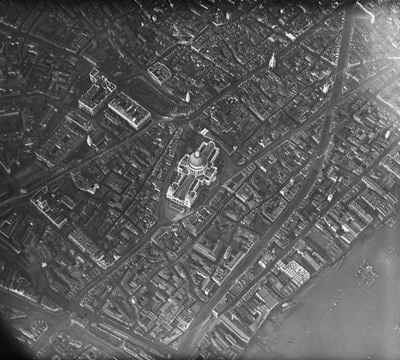
London
St Paul's Cathedral, London, 1920
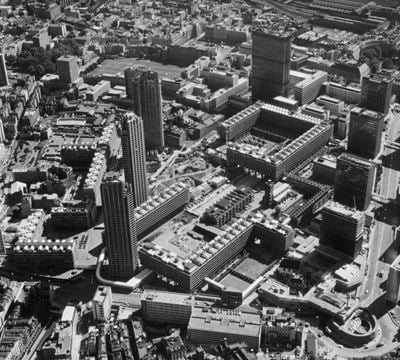
Barbican
The Barbican Estate, London, 1974
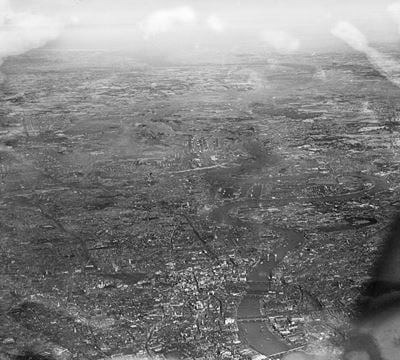
London
The view over the City and the East End of London towards the Thames Estuary, London, 1934

London
A cityscape over Whitechapel, Wapping and Shadwell, London, 1953
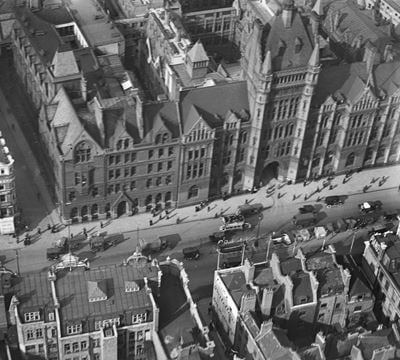
Holborn
The Prudential Assurance Building, Holborn, 1921
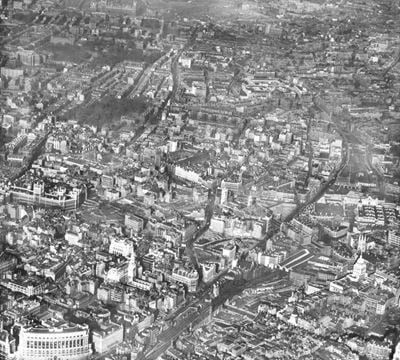
Holborn
Unilever House, Farringdon Street, Farringdon Road and environs, Holborn, 1948
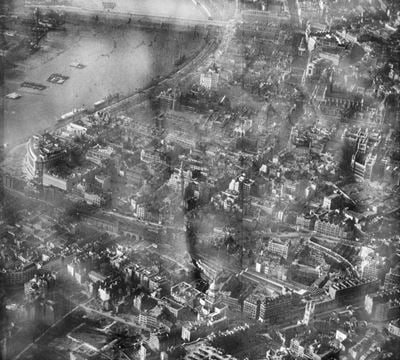
London
New Bridge Street, Fleet Street and environs, London, 1948
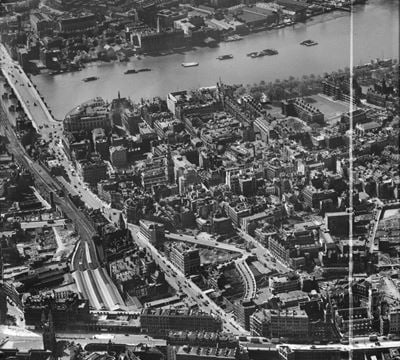
London
The area around Farringdon Street and Fleet Street, London, 1949
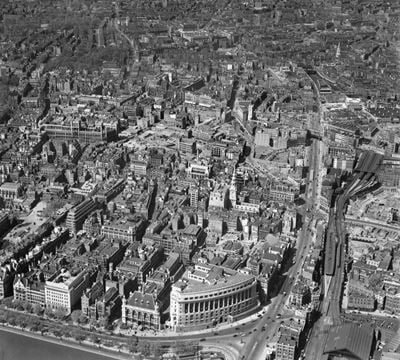
London
Unilever House, Ludgate Circus and the surrounding area, London, 1946
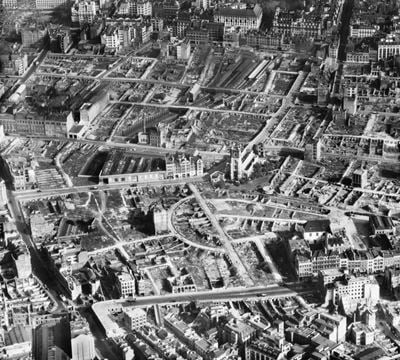
London
Cleared sites around Moorgate Street Station and Jewin Crescent following bomb damage, London, 1947
The City of London in the Historic England Archive
The Historic England Archive cares for over 15 million images, dating from the 1850s to the present day. Discover stunning images of The City of London's past. Skip this section and go to stories about heritage
Charles George Harper Collection
City And County Of The City Of London, Greater London Authority
Date created: 1892 - 1933
The Church of All Hallows by the Tower
Eric de Mare
City And County Of The City Of London, Greater London Authority
Date created: 1945 - 1980
Copy of an illustration of the Custom House viewed from the river with part of the Tower of London visible in the distance.
John Gay Collection: Railway Stations
City Of London, City And County Of The City Of London, Greater London Authority
Date created: 1970 - 1972
A view of the Thames and the new London Bridge during its construction
John Gay Collection: London
Temple, City And County Of The City Of London, Greater London Authority
Date created: 1960 - 1970
Looking through railings beside 7 Kings Bench Walk, Inner Temple showing the buildings stretching southwards towards the Thames
John Gay Collection: Modern Architects
City And County Of The City Of London, Greater London Authority
Date created: 1972 - 1975
The Old Bailey elevation of the new south wing of the Central Criminal Court seen from Limeburner Lane, EC4
John Gay Collection: Miscellaneous
City And County Of The City Of London, Greater London Authority
Date created: 1955 - 1965
An architects scale model showing the modern development around the medieval Guildhall in the City of London
John Gay Collection: Counties
City Of London, City And County Of The City Of London, Greater London Authority
Date created: 1950s
Rolls of paper manufactured by the Reed Paper Group at Aylesford Mills, being transported along Fleet Street on the back of a company lorry
John Laing Collection
City And County Of The City Of London, Greater London Authority
Date created: late 1980s
A view looking east along the River Thames from Embankment Place during its construction, showing Victoria Embankment below and the City of London in...
London, Midland and Scottish Railway Company
Minories, City And County Of The City Of London, Greater London Authority
Date created: 1880 - 1900
Timber-frames buttressing the wall of a building on Church Street, with a policeman guarding the entrance to the site and the west front of Holy...
Nigel Temple Collection of Postcards of Parks and Gardens
City And County Of The City Of London, Greater London Authority
Date created: 1900 - 1950
GENERAL VIEW OF THE TEMPLE
Walter Scott
Pool Of London, Greater London Authority
Date created: 1929 - 1930
A view of the Pool of London looking east towards Tower Bridge from beneath the north end of London Bridge, with the SS Jolly Iris moored at London...
John Gay Collection: London
Temple, City And County Of The City Of London, Greater London Authority
Date created: 1960 - 1970
Looking through railings beside 7 Kings Bench Walk, Inner Temple showing the buildings stretching southwards towards the Thames
Stories about heritage in your local area
Historic England publishes news, blogs, research, videos, and podcasts celebrating England's rich heritage. Discover the stories we have about The City of London. Skip this section and go to education
The Timeless Charm of English Market Towns and Halls
Mentions Royal Exchange
Discover the history of English market towns and halls, including farmers' markets, Christmas markets, market squares and corn exchanges.
A Brief Introduction to Christopher Wren
Mentions Cathedral Church of St Paul, The Monument
Christopher Wren was a polymath, scientist and world-renowned architect.
Secret Worlds Hidden Beneath Surface Structures
Mentions 8, Bishopsgate Churchyard, Statue of Duke of Wellington
Unusual and often puzzling surface structures can be found in our cities, towns and countryside.
Brutal and Beautiful: The Story of London’s Barbican
Mentions Barbican
London’s Barbican is arguably the greatest piece of urban architecture of post-war Britain.
5 Buildings that Survived the Great Fire of London
Mentions Church of St Dunstan in the East St Dunstan in the East (Ruin), Guildhall, Merchant Taylors Hall
On 2 September 1666, a catastrophic fire began to consume the City of London within its defensive walls.
13 Architectural Details That Reveal London’s Working History
Mentions The Daily Telegraph Building, 52-68, Bishopsgate EC2, Smithfield Poultry Market
London is full of visual clues about its rich past.
11 Unusual Architectural Details That Reveal London’s Secret History
Mentions Church of St Dunstan in the West (Including Attached Sunday School)
High up on London’s walls you will find historic and modern sculpted figures.
7 of the Best Post-war Parks, Gardens and Landscapes in England
Mentions Golden Lane Estate Designed Landscape
Here are seven of the amazing post-war parks, gardens and landscapes that exist all over England.
10 Hidden Creatures You Might Have Missed in London
Mentions Goldsmiths' Hall, 33 and 35, Eastcheap EC3, Unilever House
London’s extraordinary sculpted creatures – great and small, historic and modern – are hiding in plain sight; easy to miss when the city is full of...
8 Places That Tell the Story of London’s Resilience
Mentions Cathedral Church of St Paul, The Monument
Today and throughout history, when Londoners face challenging times we come together and show incredible resilience.
How St Paul’s Cathedral Survived
Mentions Cathedral Church of St Paul
St Paul’s Cathedral is one of London’s greatest and most loved buildings
A Brief Introduction to High-Tech Architecture
Mentions Lloyd's Building
High Tech architecture used pipes, nuts, and bolts as decoration while also serving a practical purpose.
Large Section of London’s Roman Wall Revealed After Decades Underground
Mentions London Wall: remains of Roman wall and bastion (4a) at Crutched Friars
A new development by Urbanest has revealed a large section of London’s famous Roman city wall for the first time in more than 40 years.
London’s Roman Riverside Wall Afforded Highest Level of Heritage Protection and Recognition
Mentions The Roman riverside wall and wharves at Riverbank House, The Roman riverside wall and wharves at Sugar Quay, The Roman riverside wall and wharves at Three Quays
The relatively unknown riverside wall was a massive stone structure in Roman London which connected to the landward wall, now known as London Wall.
Channel 4’s London Headquarters Listed at Grade II
Mentions Lloyd's Building
Purpose-built channel headquarters becomes one of England’s youngest listed buildings.
Historic England Voices Concerns About Proposals to Redevelop Liverpool Street Station, London
Mentions Liverpool Street Station, Former Great Eastern Hotel
The proposed redevelopment would have a severe impact on the Bishopsgate Conservation Area, and the historic character of the City of London.
The Best of England’s Post-War Parks, Gardens and Landscapes Protected
Mentions Golden Lane Estate Designed Landscape, The Barbican
Newly announced protections by Historic England are the result of a three-year collaboration with The Gardens Trust.
Liverpool Philharmonic Pub Becomes Grade I Listed
Mentions Hand and Shears Public House
News of listing upgrades to historic public houses, ranging from an opulent Victorian example in Liverpool to quaint west country village pubs.
Heritage at Risk 2019
Mentions Church of St Bride
Historic England has revealed the historic sites most at risk of being lost forever as a result of neglect, decay or inappropriate development.
Public Call-out Uncovers England’s Secret and Unknown Memorials
Mentions Memorial to Heroic Self Sacrifice
Hundreds of nominations received as public share their knowledge of local monuments, street shrines and community tributes.
1980s Buildings Officially Become Heritage
Mentions Founders' Hall, No.1 Poultry
Historic England announces the listing of 17 Post-Modern buildings
Remembering Passchendaele: War Memorials Listed
Mentions Royal Fusiliers War Memorial
Battle of Passchendaele centenary marked with 13 new and upgraded war memorial listings
Iconic Post-Modern Pumping Station Given Listed Status
Mentions No.1 Poultry
John Outram’s colourful Post-Modern Pumping Station on London’s Isle of Dogs listed at Grade II*
National Collection of Sir Herbert Baker’s War Memorials Recognised
Mentions Bank of England
15 First World War memorials by Sir Herbert Baker have been listed or upgraded to commemorate the centenary of the Commonwealth War Graves Commission.
The City of London's social history through photos
Over 10,000 images from the Historic England Archive have been specially selected and re-captioned for teachers, students, and anyone who wants to learn more about their local area. Skip this section and go to grant-aided places
Wrapping port bottles, Cutler Street Warehouse, City of London
Period: 1950s (1950 - 1959)
An interior view inside the warehouse showing a man individually wrapping bottles of Sandeman port.
Wrapping port bottles, Cutler Street Warehouse, City of London
World War II bomb damage, London
Period: 1940s (1946 - 1949)
A panoramic view of bomb damage in Cripplegate during World War II. A site has been cleared in the foreground and is being used as a car park.
World War II bomb damage, London
Tags
World War II bomb damage, London
Period: 1940s (1946 - 1949)
A panoramic view of extensive bomb damage at Cripplegate in London during World War II. The Church of St Giles lies to the right of the photograph.
World War II bomb damage, London
Tags
Workmen dismantling a tower crane while building the Barbican, City of London, Greater London Authority
Period: 1960s (1960 - 1969)
The Barbican Estate was built by John Laing plc between 1965 and 1976.
Workmen dismantling a tower crane while building the Barbican, City of London, Greater London Authority
Watch House, Bishopsgate, City of London, Greater London Authority
Period: Edwardian (1902 - 1913)
A view from Bishopsgate showing the former watch house at the corner of St Botolph's churchyard.
Watch House, Bishopsgate, City of London, Greater London Authority
Unilever House, Victoria Embankment, London
Period: 1930s (1930 - 1938)
The headquarters for the Unilever Group was built in 1930-31 to a design by J Lomax-Simpson with Burnet, Tait and Lorne.
Unilever House, Victoria Embankment, London
The Old Bell Tavern, Holborn, London
Period: Victorian (1837 - 1901)
The Old Bell Tavern and Hotel in Holborn was a coaching inn. It is seen here with a stationary hackney cab outside.
The Monument, Monument Street, City of London, Greater London
Period: Victorian (1837 - 1901)
The pedestal of The Monument, designed by Sir Christopher Wren to commemorate the Great Fire of London.
The Monument, Monument Street, City of London, Greater London
Discover more
Ready for more local heritage? Take a look at these other places nearby
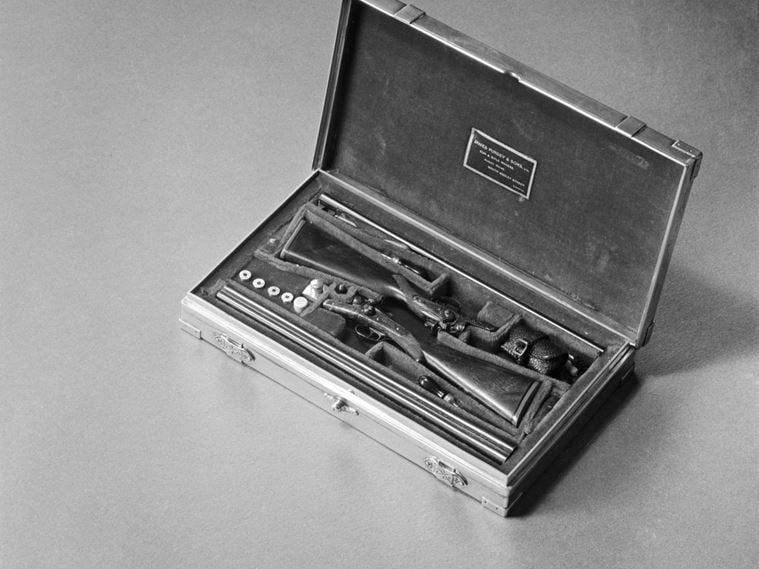
Greater London
Ceremonial County

Tower Hamlets
Local Authority District

Islington
Local Authority District